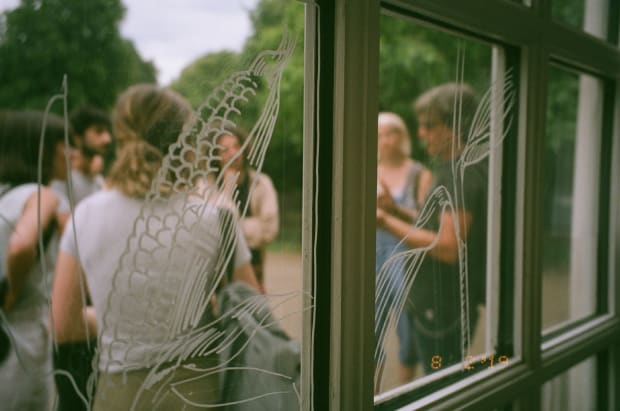-
ADHAM FARAMAWY & RACHEL PIMM
IN CONVERSATION -
Adham Faramawy: I love Rachel’s way with research, I have to say it. I love the depth of feeling they share when they talk about plants but actually the first time we met I was struck by the way that they were building community through their art practice. Rachel was part of a group of three artists (Rachel along with Kate Cooper and Amanda Dennis) who founded a studio and exhibition space called Auto Italia which initially was based in South London, off Old Kent Road but now relocated to Bethnal Green. I was also working in groups and collectives at the time so I was excited to see similarities in the ways we approached things.
-
AF: Collaborating and finding ways to work together seems to be pretty central to your approach, but I see this in your approach to researching materials, the care you take tracing webs of association, of cause and effect between materials, plants, people and places. Can you tell me a bit about how and why you started working as part of Auto-Italia?
-

-

-
AF: Back in 2017 (which feels like yesterday and forever ago) I saw a show of yours called ‘Resistant Materials’ at Hales Gallery in London. I remember feeling a real affinity with your process. I’d been thinking about how the ways I’d been taught or encouraged to make and exhibit art seemed to penalize complexity, particularly complexity of experience where often contradictory experiences need to sit together. I remember looking at this body of work and research and all the entanglement and multiplicity of material, process and labour that went into making a white tile and I was kind of awe struck. Can you tell me a bit about the research that went into making that show? And why the white tile?
-

-

-

-

-
In general, I wanted to think of landscape and writing as a responsibility to the planet and others, and about geology as a state of flux.
RACHEL PIMM
-
AF: You were a writer in residence at Whitechapel Gallery for much of 2020. Can you tell me a bit about what you did there?
-

-

-

-

-
AF: Ok, let’s talk about plants.
RP: Lovely!
AF: We both work quite closely with plants, and I’ve seen pictures of your flat, which looks kind of like a forest with walls. I’m interested in looking closely at plant and animal biology, the ways we name them, the ways they migrate, what they look like, feel like, what it is to touch and dance with them, as a way to denaturalize human desire, and when I say denaturalize I mean finding a way to deprogramme myself from the idea of cis-heteronormativity as neutral, or as the norm which creates or presupposes ideas of deviation or the un-natural. Which plants have you been looking at lately and what fascinates you about them?
-

-

-
So yes, for the moment it’s weeds for me. And I count mushrooms in that category- the uncultivated. I like how in your work, you find the kind of sticky to the touch potential in the bodies of mushrooms and plants. Plants make a mockery of us organising them, and of the rigid cultures we seem to perpetrate. Weeds are not only ubiquitous and so pretty accessible, they are really great candidates for this type of queering or disobedience.
-
AF: I know that tracing colonial histories and thinking about decolonisation has been important to you and I wondered if you might talk a bit about why this became urgent for you and how it’s influenced the work you've been doing with community gardener and organizer Carol Wright of Blak Outside?
-

-

-

-
If we are thinking from within the queer circle, thats great, its a space to hold, shape, celebrate. I love being here. I love queer family, queer community.
Rachel Pimm
-

-
This isn’t that though. It's pretty easy to tell the difference between instrumentalisation, representation and support. If we are thinking from within the queer circle, thats great, its a space to hold, shape, celebrate. I love being here. I love queer family, queer community.
-

-

-

-

-
READ MORE FROM ADHAM



























